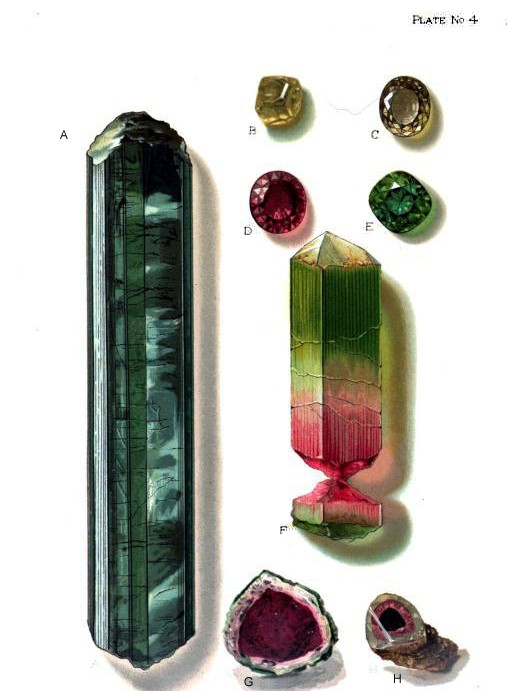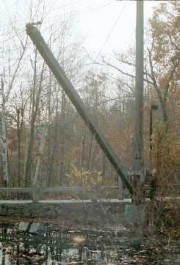Mining has been significant part of the Maine economy at different times in different places, thanks to its geologic composition. Granite, slate, and gem extraction have been important local industries at certain points in the state’s history.
The Mt. Mica mine in Paris, Maine was the site in 1820 where amateur naturalists Elijah Hamlin and Ezekiel Holmes virtually tripped over a clear green crystal, the first gem tourmaline discovered in the United States. According to an exhibit in the Peabody Museum at Harvard University,
For years, mining on Mt. Mica continues as a small-time affair. More ambitious mining began in 1868, when Elijah Hamlin and his son Augustus launched a blasting program that uncovered new pockets. They discovered beautiful gem-quality tourmaline in a rainbow of colors . . . .
Interestingly, tourmaline, the “official” state mineral, has links to another mining industry – granite. Pegmatite – a type of coarse granite – is filled with crystals, including topaz, garnet, aquamarine and tourmaline.
A. Blue tourmaline [indicolite], Mount Mica, Paris, Maine. [New York State Cabinet]
B. White tourmaline [achroite], De Kalb, St. Lawrence County, New York.
C. White tourmaline [achroite], Mount Mica, Paris, Maine.
D. Red tourmaline [rubellite], Mount Mica, Paris, Maine.
E. Green tourmaline, Mount Mica, Paris, Maine.
F. Crystal of tourmaline, Mount Mica, Paris, Maine [Hamlin Collection].
G. Section of a crystal of tourmaline from Mount Mica, Paris, Maine, showing a red and white center with green exterior.
H. Section of a crystal of tourmaline from Mount Mica, Paris, Maine, showing dark blue and pink center with white exterior.
Northwest of Paris, in Newry, prospectors discovered the Dutton Mine in 1898. But is was not until 1972 that three friends blasted open a pocket at the then abandoned mine and found the walls ablaze with sparkling red and green tourmalines. According to the Peabody,
In just four weeks, they removed more than a ton of tourmaline – the biggest find ever in North America, and on of the great finds in the world. In addition to tourmaline, the amazing vein contained one quarter of all the mineral types known in Maine. Mining at Dutton ended in 1974, when the deposits were exhausted; the landowner collapsed the tunnels as a safety precaution.
Monson and Brownville, both in southern Piscataquis County, were famed for their high quality slate. In fact Brownville’s won first prize at the 1876 Centennial Exposition in Philadelphia.
The demand for granite for buildings, bridges and pavement was booming in the mid-nineteenth century. Quarries from coastal communities, such as Sullivan, Franklin, Vinalhaven, Stonington, were booming. The stone was sent by ships to the cities for use in the emerging skyscrapers.
A Brief History of the Granite Industry
Maine was first in the nation for granite production at the beginning of the 20th century. In 1901 the Maine Bureau of Industrial and Labor Statistics reported 152 known quarries employing at least 3,500 men.
The small granite building that now houses the Hamlin Memorial Library was built in 1822 to house the Oxford County Jail. Dr. Augustus Choate Hamlin, a nephew of Hannibal Hamlin, purchased the old jail, and in 1902 deeded it to the Paris Hill Library Association to be a library and museum.
The industry was a significant element in the Maine economy from the mid-19th century to the mid-20 century. Much of its success was due to profitable contracts from the U. S. government for the construction of public buildings.
By 1877, granite workers began to organize unions, based partially on the large profits flowing to the owners and the perceived need to establish uniform wage rates and improve working conditions. The organizing meeting of the Granite Cutters Union was held at Clark Island, in the town of St. George, on January 2, 1877.
Nearby Dix Island hosted a very active granite industry in the 1870’s. In 1871, authorities responsible for building the new capitol in Albany, New York, visited Dix as well a quarries in Hallowell and Vinalhaven.
The steam yacht Fire Fly, owned by the Dix Island Granite Co,, carried Speaker James G. Blaine, Senator Samuel P. Morrill, and other dignitaries to Dix Island . . . [for] an inspection of the island’s granite works. [Grindle, p. 27]
Among the many communities with granite quarries were Biddeford, Blue Hill, Frankfort, Franklin, Hallowell, Norridgewock, Sullivan, Stonington, and Vinalhaven. In the early 20th century many of the smaller companies were purchased or leased by out-of-state construction companies to guarantee a supply of material.
The addition to the Maine State House was made with granite from Hallowell’s H. L. Brown Company.
Grindle lists over 210 granite firms in business at some time between 1891 and 1946 in Maine.
World War II interrupted most of the industry’s business and soon thereafter steel and concrete began to replace granite except for special ornamental applications in major building projects. Little remains of the once important industry that contributed much to the grant public and private buildings in the eastern United States.
Additional resources
Bastin, Edson Sunderland. Geology of the Pegmatites and Associated Rocks of Maine: Including Feldspar, Quartz, Mica and Gem Deposits. Washington. Government Printing Office. 1911.
Blakemore, Jean. We Walk on Jewels; Treasure Hunting in Maine for Gems and Minerals. Rockland, Me. Seth Low Press. c1961.
Grindle, Roger L. Tombstones and Paving Blocks: The History of the Maine Granite Industry. Rockland, Me. Courier-Gazette. c1977.
Hamlin Memorial Library. http://wdb.sad17.k12.me.us/libraries/paris.htm (accessed 2/29/2008)
Kunz, George Frederick. Gems and Precious Stones of North America. New York. 1890. Plate #4. Public domain image and notes are from http://www.mindat.org/photo-209889.html (accessed January 24, 2012)
Maine Geological Survey. Maine Granite Quarries and Prospects. Augusta. Department of Economic Development. 1958.
“Stone Quarries and Beyond: Maine.” http://quarriesandbeyond.org/states/me/maine.html (accessed November 29, 2014)
Watts, Joan, collector. Interview with Bjarne Peterson. St. George, Me. 1977. Mr. Petersen began as a stone cutter in Norway at age 9 before immigrating to the U. S. at age 17 to work at quarry stone cutting mostly for the Clark Island Quarries in Maine. Topics cover his immigration experience in 1923, explanations of quarry operations, tools, etc. especially as they relate to stone cutting, his work helping cut stone for buildings at West Point (New York), Italian stone cutters working in Egypt (Maine?), wages, and home life. Materials located in: Northeast Archives of Folklore and Oral History, Maine Folklife Center, University of Maine, Orono
Call Number: HABS ME,9-PARHI,3–3. Repository: Library of Congress Prints and Photographs Division Washington, D.C. 20540 USA http://hdl.loc.gov/loc.pnp/pp.print




